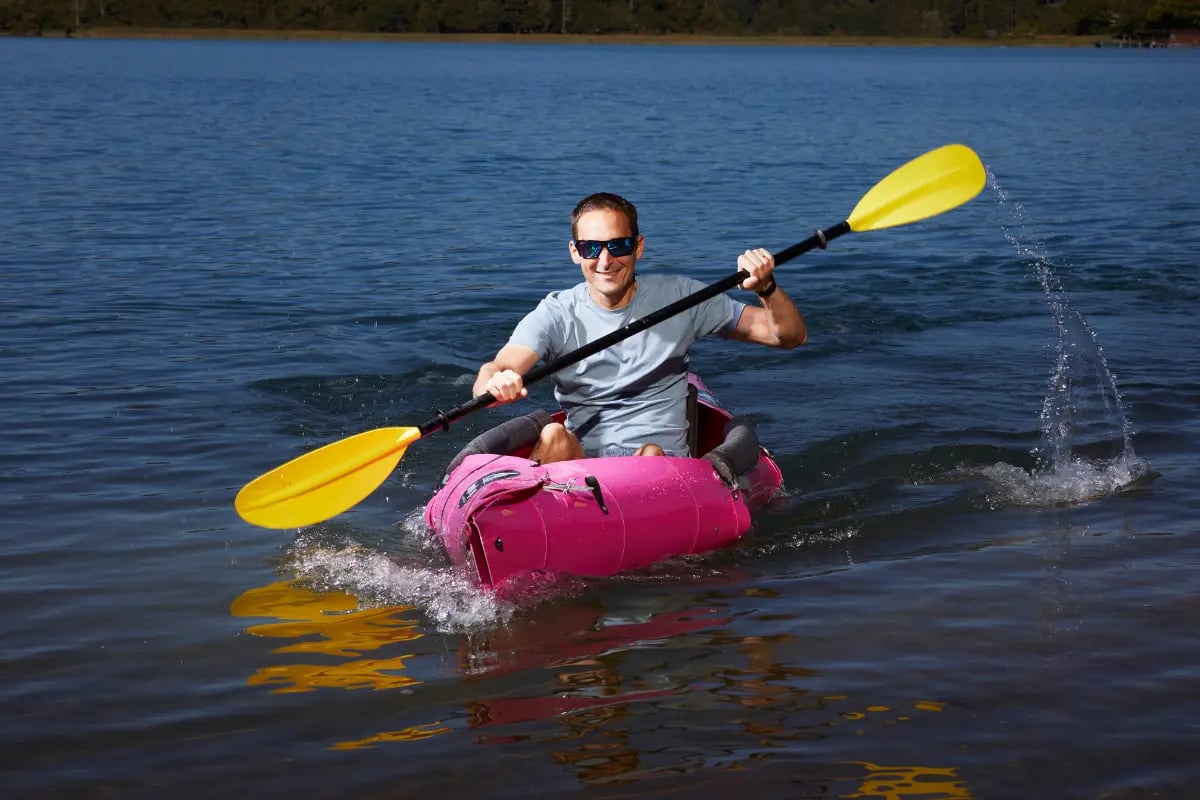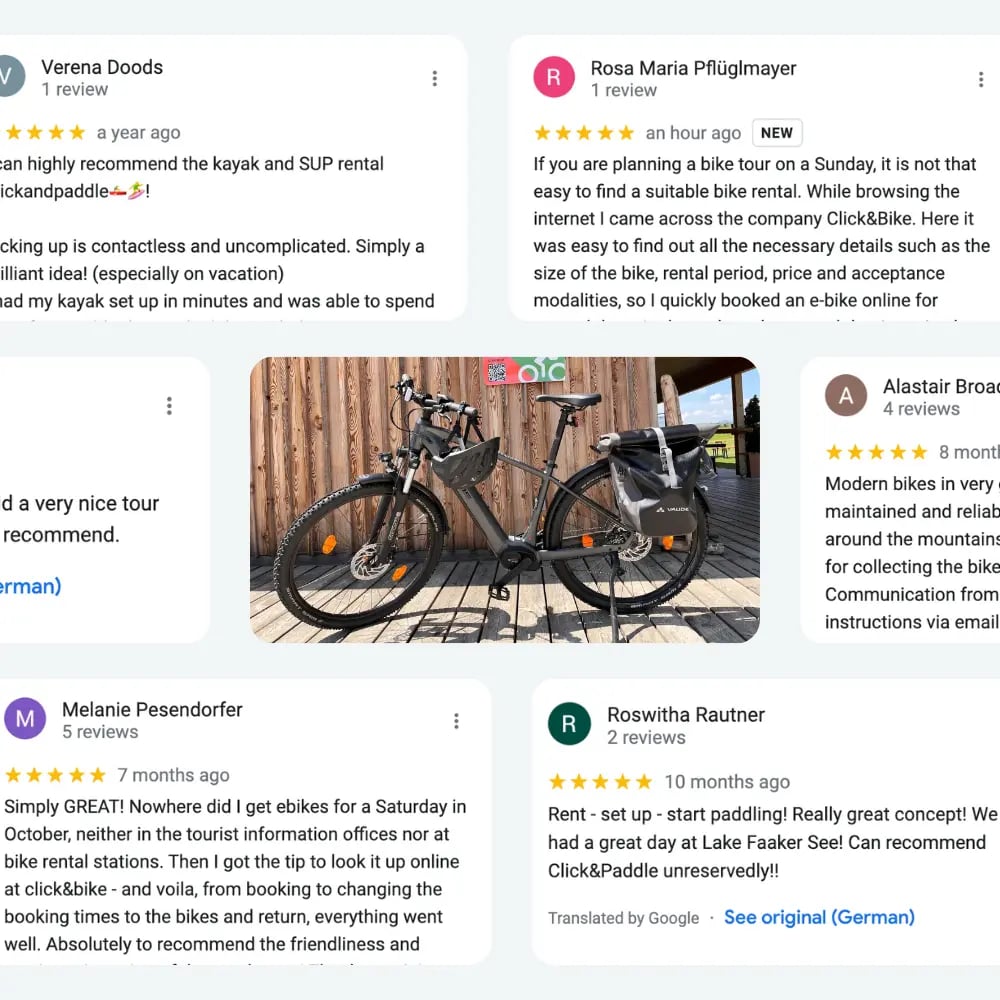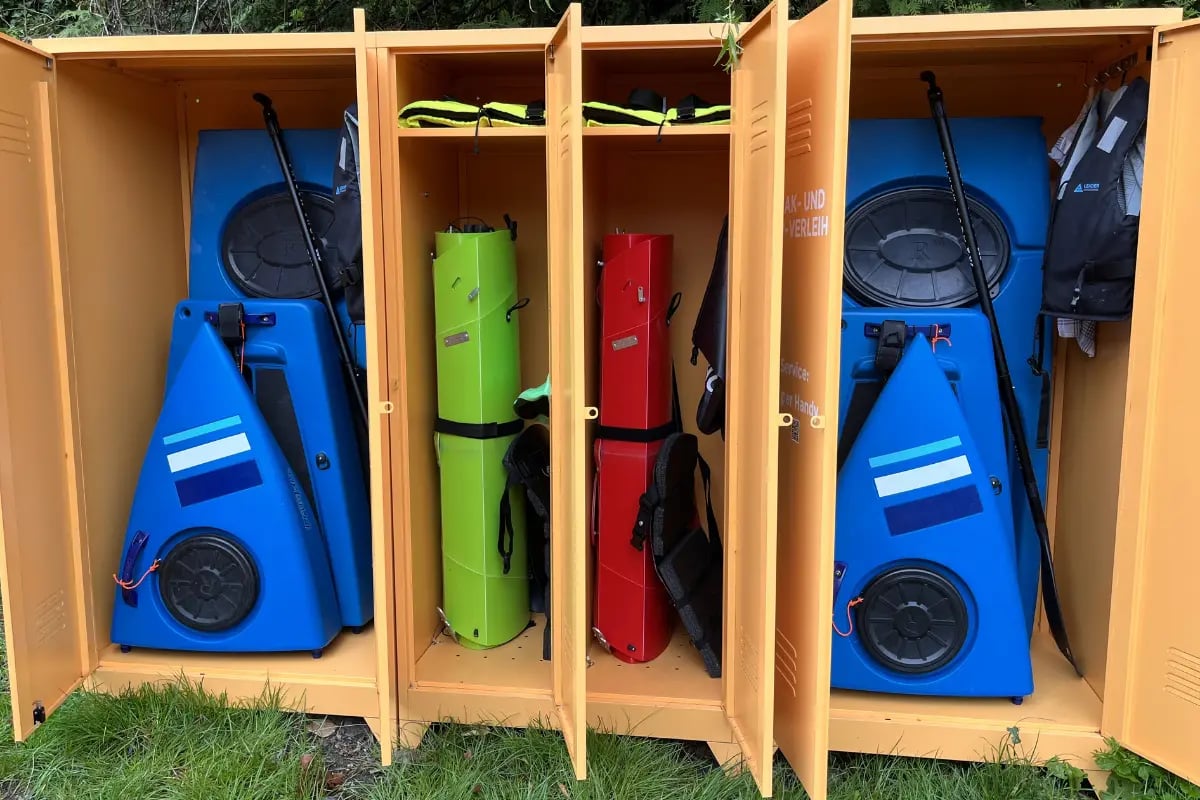In the rapidly evolving world of sharing economy, there's been a lot of buzz around the concept of automated rental systems. From vehicles to tools and sporting goods to trailers, the global rental market has quickly recognized the enormous potential of automated, unstaffed rental stations.
Today, companies of all sizes are on a quest to streamline their operations and enhance customer experience. In this article, Thomas Dickhoff, a German software architect and rental company entrepreneur based in Austria, tells us how his automated rental stations for kayaks, stand-up paddleboards, and bikes provide operational efficiency and customer satisfaction.
We also discuss Thomas' new venture, Click&Share, which builds customized automated systems for other rental companies.

Thomas came up with the idea of renting kayaks as he was looking for a fun side project during the pandemic. He quickly discovered the inconvenience of managing rentals manually. Photo: Johannes Puch.
Understanding automated rental systems: A look into Click&Share's concept
Automated rental systems have risen as a game-changing solution in the rental industry, simplifying the process from start to finish. According to Click&Share, no matter what equipment is rented - be it bicycles, hiking gear, or kayaks - every aspect of the process can be automated, creating a streamlined experience for both the business and the customer. Okay, almost everything. Maintaining and cleaning the products between orders still requires manual work. However, these actions are not time-bound, allowing Thomas to schedule them in the windows that suit him best.
A software architect from his background, Thomas was brought to the rental industry by coincidence. Thomas and his wife had moved to a lake and bought two foldable kayaks for their personal use. At the same time, he was looking for a fun side project during the pandemic and soon realized that these kayaks were optimal for sharing. However, without any prior experience in running a rental business, he quickly discovered the inconvenience of managing rentals manually.
But he didn't give up and approached the problem as any software architect would: minimizing manual intervention as much as possible.
At first, it took me some time to make the connection between what I'm doing in my day job and what I'm doing with rentals. But I found a common thread from automating transaction processing. My entire mindset is about minimizing manual intervention as much as possible.
At its core, an automated rental system is designed for optimal convenience. Customers can quickly check the availability of individual rental items online and complete the booking with all essential details. Payments and possible deposits are processed digitally, with options for credit card payments, PayPal, Apple Pay, and Google Pay, among others, eliminating the need for physical transactions.
What makes the rental operation even more efficient is the automated communication. Collection and return details are automatically emailed to customers, saving time for the staff and guests. Furthermore, the collection and return processes are contact-free and executed using an electronic key or PIN code, making it safer and more convenient.
Drawing inspiration from automated mobility solutions like bike and car sharing, Click&Share has adapted this concept to cater to high-quality rental equipment for locals and tourists looking for recreational activities. The main objective is to provide an optimized, seamless, and efficient rental experience, providing maximum value to the customer while reducing the workload for staff, ensuring a win-win scenario for all stakeholders.
And it seems to work. Click&Paddle has grown from the initial two kayaks to ten kayaks and six stand-up paddleboards spread across three stations in two years. Furthermore, Click&Paddle has been joined by Click&Bike, which offers six electric bikes for hire. Not bad, taking into account that Thomas also has a day job.
All this would not be possible without the time savings from automation, but reading the customer reviews Thomas has received on Google, it's easy to see that the concept resonates with end-consumers.

What started as a small side project focused on renting kayaks has now developed to the point where other rental companies in the region are also interested in the systems developed by Thomas. That's how Click&Share was born.
It was never my plan to develop a B2B solution, rather this was a side project that I found enjoyable. However, over time, other businesses started expressing interest in the solutions I created. Despite my initial reluctance, I came to realize that there was a real demand for what I had built.
Applications of automated rentals: A world of possibilities
The beauty of automated rental systems lies in their versatile applicability across various industries. In truth, there's hardly an industry that couldn't reap significant benefits from automation. It all boils down to identifying what processes make sense to automate and how best to execute it.
Click&Share envisions its solution as a powerful tool for any business seeking to offer rental products with minimal effort, perhaps even as a complementary addition to its core business operations. This includes a diverse range of enterprises such as hotels, guest houses, campgrounds, tourist information centers, sports facility operators, and sports shops. Currently, Click&Share is helping companies rent recreational items like bicycles and other sports equipment, but the potential does not stop there.
You can easily see extending this service to different product categories, such as tool and trailer rentals. For instance, home improvement stores or white goods retailers could significantly improve their customer experience and loyalty by incorporating a relevant rental service.
Looking ahead, I believe we need better rental solutions, or what you might call frictionless solutions. These save effort and cost for the merchant and customer alike, which in turn, increase profit margins. In the long term, as more systems like these are used, merchants will likely lower prices due to competition. And that is exactly what is needed to foster sharing-based consumption. For instance, renting an e-bike here for a day costs around 50-60 euros, which is quite high. If we want to promote more sharing, we need to bring the prices down, make it easy, and widely available.
The potential applications of an automated rental process are vast and varied, providing a novel way for businesses to differentiate themselves in a competitive market. Ultimately, such systems could mark a significant stride toward operational efficiency, customer satisfaction, and faster adaption of circular and sharing-based business models.
The benefits of automation on equipment rental
While personal touchpoints are still valued, the undeniable advantages of an automated rental system cannot be ignored. From improving flexibility and convenience to streamlining operations, the benefits are manifold.
Saves effort and personnel costs
With an automated rental management system, the need for staff intervention in every step of the rental process is significantly reduced. Tasks such as checking inventory availability, accepting payments, and communicating pick-up and return details can be done automatically. This reduces the workload for staff and contributes to substantial savings in personnel costs. Additionally, it frees up staff members to focus on more strategic tasks, improving overall productivity and operational efficiency.
Increases sales thanks to longer opening hours and better accessibility
One key advantage of automated rental systems is that they operate around the clock. They are not constrained by traditional business hours, enabling customers to conveniently book, collect, and return rental items. This extended accessibility naturally leads to increased sales opportunities. Moreover, online availability and booking allow customers to access the service from anywhere, further driving rental demand and sales.
Allows renting when and where it would otherwise not be possible
One of the key customer value drivers enabled by automated rental systems is the ability to keep the business open when it would not normally make sense or take the equipment rental offer to places where it would not otherwise be possible, either due to low demand or other circumstances.
In these cases, an automated rental station can be the solution to provide the rental service during times when there is not enough demand to keep the shop open or in locations where it would be otherwise challenging to run a profitable rental business.
Enables short rental times as the rental process becomes cost-neutral
Automated systems significantly reduce the time and cost associated with the rental process. This efficiency allows shorter rental periods, which might not have been financially viable with a manual process. Customers seeking rentals, even for an hour or two, can be accommodated easily, broadening the customer base and increasing rental turnover.
Optimizes inventory utilization
With real-time tracking and accurate inventory management, automated rental systems optimize the use of available assets. They prevent overbooking and ensure a better distribution of rentals over time, maximizing inventory utilization. Furthermore, they provide valuable insights into usage patterns and customer preferences, aiding in strategic decision-making for inventory planning.
Eliminates waiting times during booking, pick-up, and return
By digitizing the rental process, automated systems eliminate waiting times traditionally associated with booking, pick-up, and return procedures. Customers can make instant bookings online, collect and return items using electronic keys or PIN codes, and receive automatic confirmations. This speeds up the process considerably, making the rental experience more enjoyable and convenient for customers.
Great additional offer or customer magnet
In today's competitive landscape, businesses must continuously innovate to attract and retain customers. An automated rental service can be a compelling addition to a business's offerings, drawing in new customers seeking convenience and flexibility. It can also boost customer loyalty by providing a seamless and efficient rental experience all under one roof, where they do their business anyway.
Setting up an unstaffed rental station step-by-step

We've discussed the concept and benefits of automated rental operations, but what are the concrete steps you need to take to set up an automated rental station? Find out below.
1. Develop a process plan
The journey towards an automated rental station starts with a thorough process plan. Outline the rental operation's structure, and define each step of the customer journey. This journey begins with the initial booking and ends with the equipment return. Understanding these stages allows you to design a process that creates value for your customers while aligning with your business model.
2. Identify your hardware and software needs
An effective automated rental station requires the right blend of hardware and software. The hardware could include secure lockers for storing equipment and smart locks or other access systems. Evaluate if the existing infrastructure can be re-used, e.g., in many cases, adding an electronic lock to the storage room for rental equipment is possible.
The software, on the other hand, is the centerpiece that connects everything. That can include the online booking system, payment gateway, and automated email system for communication. Assess your needs and choose solutions that best fit your requirements and budget.
3. Build a prototype and test how everything works
Once you've determined your process and identified the necessary hardware and software, it's time to build a prototype. Test your system thoroughly, using yourself or a friend or family member as a test customer.
Pay close attention to potential shortcomings or areas for improvement. Collect feedback and make any necessary corrections. This step is crucial to ensure that the system works smoothly before you go live.
4. Get the inventory, business premises, and necessary permits you need to launch your business
With your tested prototype in hand, you're now ready to launch. If you are starting from scratch, you still need to source the necessary inventory, secure the business premises, and acquire any permits required by your local regulations.
Conduct a final series of tests to ensure everything is functioning as expected. Once everything is in place, it's time to start marketing your business and acquiring customers.
Conclusion
The convenience, efficiency, and round-the-clock availability of automated rental stations elevate the customer experience, while their operational benefits help businesses reduce costs, optimize inventory, and enhance sales opportunities. The increased flexibility and improved accessibility undoubtedly pave the way for more consumer-friendly concepts in the rental industry.
However, setting up such a system might seem like a daunting task, with perceived complexities around software-hardware integrations and operational transitions. This is where solution providers like Click&Share come into play. Their expertise in software development helps businesses to get started with automated systems with a relatively low investment compared to the benefits to be gained.
Click&Share offers a bunch of features that can be used one by one or collectively. They don't necessarily need to result in full automation. For instance, a Twice user could decide to simply have a nice personalized confirmation email with automated follow-ups. For unmanned rental stations, Thomas has built connections with smart locks that can be tailored to specific scenarios.
While the future of the rental industry is set to be largely automated, the journey there need not be complicated. With strategic planning, the right technology, and expert guidance, businesses of all sizes can harness the immense potential of automated rentals, driving their growth and the evolution of the entire industry.
Interested? Thomas offers his services globally, so don’t hesitate to throw him a message.









